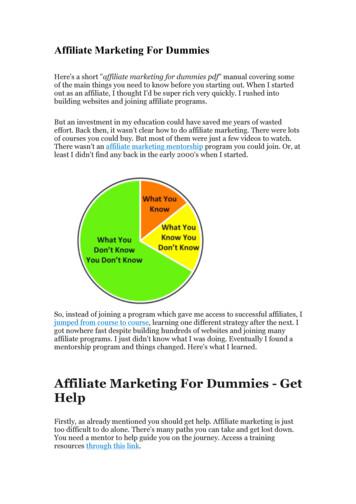Affiliate Marketing: Affiliate Marketing Fundamentals
Affiliate Marketing: Affiliate Marketing FundamentalsTitle: Affiliate Marketing: Affiliate Marketing FundamentalsCourse material - knowledge required - for certificationCopyright 2018 eMarketing InstituteWeb: www.emarketinginstitute.orgContact useMarketing Institutec/o Web Media ApSTove Maës Vej 7, 3.tv.DK-2500 Valby, CopenhagenDenmarkVAT ID: DK 3531871301Email: support@emarketinginstitute.org2
1. Introduction . 9Affiliate marketing. 10Affiliate marketing statistics . 102. What Is Affiliate Marketing? . 14The origin and development of affiliate marketing . 14Affiliate marketing defined . 15Digital buyers . 15Getting started . 16Types of affiliate websites. 17Benefits of affiliate marketing . 17Benefits for merchants . 18Benefits for affiliates . 193. Becoming a Merchant . 22What is a merchant? . 22How to become a merchant?. 23Create a plan . 23Set up goals . 29Choose a network/software . 30Promo material . 30Strategy to promote the program . 31What to expect? . 314. How to Become an Affiliate . 34What is an affiliate? . 34How to become an affiliate? . 34Online presence . 35Essentials. 35Choosing the program . 36Joining the affiliate program . 37Strategy to promote the affiliate links . 393
What to expect? . 405. Managing an Affiliate Program . 42KPIs (Key Performance Indicators) . 42The number of affiliates. 42Average activity percentage . 43Traffic . 43Sales . 44Conversions. 45Communication methods. 45Automated communication . 45Ongoing communication. 46Elements of good communication . 46Managing affiliates . 476. Affiliate Marketing Compensation Models . 51Pay per sale (PPS) . 51Pay per action (PPA) . 52Pay per call . 53Pay per install . 53Pay per click (PPC) . 53Pay per mile (PPM) . 53Void affiliate transactions . 547. Affiliate Marketing Strategies for Merchants . 57Website . 57Affiliate program page . 57Landing page . 57Social media . 58Scout for affiliates . 59Attach reviews . 59Gain trust . 594
Newsletter subscribers . 59Affiliate networks . 60Affiliate directories. 61Affiliate program manager . 61Monitor and combine . 618. Affiliate Marketing Strategies for Affiliates . 64Product reviews . 64Product mention . 66Banners . 68Coupons . 68Affiliate marketing on YouTube . 68Analyze performance . 709. Affiliate Networks . 73What is an affiliate network? . 73How do they work? . 73Merchants . 73Affiliates . 76Top five affiliate networks to join . 78CJ Affiliate . 78ShareASale . 79Rakuten (former LinkShare) . 81Webgains . 83FlexOffers . 8410. Affiliate Software . 88What is affiliate software? . 88Self-hosted software . 88Hosted software. 88How do they work? . 895
Admin panel . 90Affiliate panel . 90Top five affiliate software to use . 91iDevAffiliate. 92AllAffiliatePro . 93Post Affiliate Pro . 94JROX . 96LinkTrust. 9711. Popular Affiliate Programs . 101Amazon affiliate program . 101eBay affiliate program . 104Target affiliate program . 106Jet . 107Other affiliate programs to explore . 10812. Affiliate Marketing Tools to Use . 111Essentials . 111Research . 112Content. 113Links and tracking. 114Email marketing . 114Social media . 115Paid campaigns. 116WordPress Tools . 11613. Potential Issues with Affiliate Marketing . 119Fraudulent affiliates . 119Automatic approval of affiliates. 120How to approve affiliates? . 120Cookie stuffing . 1216
Trademark violations . 122Motivating affiliates . 123Tactics to help you motivate affiliates . 123Affiliate marketing scams . 12414. Affiliate Marketing and Online Marketing . 127Affiliate marketing and search engine optimization (SEO) . 127Affiliate marketing and search engine marketing (SEM) . 129Affiliate marketing and social media marketing (SMM) . 131Affiliate marketing and email marketing . 133Affiliate marketing and influencer marketing . 134Conclusion . 13615. Affiliate Marketing Glossary . 13916. Questionnaire . 146Questions . 146Answers . 15917. Conclusion . 161Integrating affiliate marketing with your business . 161Growing your business with affiliate marketing . 162Expansion . 162Involvement . 162Mobile-friendliness . 1637
1Introduction8
1. IntroductionThe online world has tremendously affected our everyday lives that sometimes it might evenseem impossible to imagine our lives without technology and online communication. This trendnaturally transferred to the business world, where the new technologies opened up so manyexciting opportunities. The businesses out there were no longer confined by location orrestricted by infrastructure. Once everyone hurled to the big cities because these have beenplaces enabling your business to grow. Businesses needed more qualified employees, theywanted exposure to more customers and opportunities to network and create partnerships. Allof these required your business having headquarters in a big city, but this is no longer needed.All you need is a computer and the internet connection, and you are ready to take yourbusiness anywhere you want.Image: https://unsplash.com/photos/EZSm8xRjnX0Speaking of the business world, this term has so long been used in relation to big corporationsand management teams, but nowadays, we see more and more one-man businesses that growand expand their reach globally. There is a significant number of businesses completely set upand run by a single person. Or they start as such, only to expand as their influence online9
begins to increase. Entrepreneurship has become a popular business model which helped somany wonderful business ideas come to life.The possibilities on the market are numerous, especially if we have in mind the online market.There are so many different ways and strategies to set up and grow a business, depending onthe niche, resources, knowledge, etc. What is safe to say is that these opportunities are a partof the online world, and new opportunities keep popping up. One of those is affiliatemarketing.Affiliate marketingWhile every business starting out nowadays will first create a website, optimize it and thenhead to social media to establish a presence there, not everyone will consider affiliatemarketing as an opportunity at first. The goal of this ebook will be to show you the realpotential of affiliate marketing and how developing a strategy of your own can help your profitssoar and your business grow.For starters, you will need to understand the difference between being a merchant and anaffiliate because these require two completely different strategies. In fact, these can developyour business in different ways, so you can either focus on one or choose to be both, amerchant and an affiliate, which, although less frequent, is still doable. You will also learn aboutbusiness models that are available in affiliate marketing. Affiliate programs and tools will beessential parts of your strategy, which is why you need to learn about those as well. Your goalwill be to learn as much as possible about affiliate marketing opportunities and about differentaffiliate programs and tools that enable you to form your own custom strategy, an approachand a plan which will be oriented towards one idea – improve your business through affiliatemarketing.Affiliate marketing is a part of online marketing, which means it is connected and related to allof the segments of online marketing. This is why there will be a chapter about this connection,and how using affiliate marketing requires at least basic knowledge of online marketing ingeneral.Affiliate marketing statisticsBefore defining the term and analyzing this concept of affiliate marketing, it is helpful to have inmind a couple of statistics that illustrate the state of affiliate marketing in the business world atthis moment.10
Approximately 15% of the digital media industry's revenue now comes from affiliatemarketing. (BusinessInsider) Over 50% of top affiliate programs fall into 4 categories: Fashion, Sports, Health &Beauty, Travel (AMNavigator) Top factors for choosing an affiliate program are product or service relevancy(18.15%), affiliate program reputation (15.97%) and affiliate network or trackingplatform (11.58%). (AffStat) The most common places to find new affiliate programs include information on themerchant’s website, searches on Google and affiliate network websites. (AffStat) Affiliate marketing will affect 14% of all e-commerce purchases in the United States.(DigitalCommerce360) With the power of social media, content publishers, and a plethora of digital mediareadily available at their fingertips, today's consumers are more educated andshopper-savvy than ever before. (Rakuten) When it comes to purchasing decision, price point had the most influence on aMillennial (62%), outweighing recommendations from a friend (55%), brandreputation (47%), and product quality (35%). (Rakuten) Mobile devices were crucial for Millennial mothers to search for the best possibleprice of a product (79.4%), read reviews (68.9%), and download coupons (67.1%).Even in-store shopping was greatly influenced by Millennial mobile users, with overhalf (52%) comparing prices to other retailers. (Rakuten) More than 30% of affiliate-generated sales originate from a mobile device. (Awin) Nearly 50% of affiliate-referred traffic originates from a mobile device. (Awin) 40% of marketing professionals quote affiliate marketing as the most desired digitalskill. (AMNavigator)What we can conclude about affiliate marketing is the following: Affiliate marketing has (and will continue to have) an important role in e-commerce.11
Affiliate marketing is an amazing opportunity to increase sales (and revenue) forboth merchants and affiliates. Content is the best way to promote affiliate links. Working on authenticity and reputation is the best way to earn credibility online andthus increase the profitability of affiliate marketing. Mobile is affecting affiliate marketing as well, which means mobile user experienceis something merchants and affiliates need to focus on.12
2What Is AffiliateMarketing?13
2. What Is Affiliate Marketing?As one of the strategies available to online businesses, affiliate marketing offers plenty ofopportunities but before you get started you need to understand the entire concept and whatit is all about.The origin and development of affiliate marketingThe entire concept of affiliate marketing is focused on sharing the revenue by partnering upwith others, and it is the concept that has been around for a while before the world wide webeven started. In terms of affiliate marketing as an online business model, we can trace back itsorigin back to 1994 when the first affiliate program was launched by PC Flowers & Gifts. Oneyear later, they had over 2000 partners in their affiliate program. Perhaps the best-knownaffiliate program today, Amazon’s affiliate program, was launched in 1996. In fact, e-commercewebsites, in general, started seeing affiliate marketing as an excellent way for them to increasesales without any direct promotion from their part.Image: line-2125548/14
Even though there have been several business models in affiliate marketing, what reallychanged the game was the introduction of Web 2.0. This shifted the focus to the usergenerated content, optimization, and integration of social media.As a result, affiliate marketing became even more available to the ordinary people, bloggers,influencers, etc. who suddenly started seeing this type of marketing as a perfect way for themto monetize their online influence. No longer has this partnership been available for businessesonly, but individuals started taking a massive role in the concept, changing the world of affiliatemarketing for good.Affiliate marketing definedAffiliate marketing is a type of performance-based marketing. This means that the efficiencyevaluation and reward systems are based on the performance, which can be evaluated atspecific intervals, or it can have a particular goal that needs to be achieved.There are two roles in affiliate marketing which are crucial for this entire system to work. First,there are merchants, who decide to create an affiliate program. They provide an offer forothers to promote their business and earn their commission. On the other side, there areaffiliates, who are also known as publishers. They are the ones that are interested in joining anaffiliate program.The main reason for merchants to create an affiliate program in the first place is the potentialto increase sales and boost profit with no direct promotional campaign, except for enablingaffiliates to join the program. Since the entire concept of affiliate marketing is performancebased, there is no investment or pre-payment required by the merchants.Affiliates are also motivated by profit to join an affiliate program. Once they enter the program,they are able to promote the merchant’s products in any form they can, in order to increasesales. Their performance is tracked using trackable links and they are paid based on thatperformance, i.e., based on the conversions they achieve.Digital buyersApart from merchants and affiliates, who take an active role in affiliate marketing, it is alsoimportant to mention digital buyers. These are the modern consumers who are experiencingthe buying process in a completely different way nowadays. Not only does the habit of buyingonline instead of offline changes rapidly, but the way the consumers buy is also changing.Digital buyers are more prone to explore products before they buy. This is how showroomingand webrooming were introduced in e-commerce. Nowadays, buyers want recommendations,15
and they want to see the benefits of the product. In fact, they look for recommendations fromfriends and people they respect (bloggers, influencers, etc.).All of this has a positive influence on affiliate marketing because it increases the chance ofonline buyers finding the products through recommended (affiliate) links. Furthermore, a lot ofsurveys show that affiliate marketing drives performance, which includes brand discovery andawareness, as well customer engagement and purchase. Affiliate marketing basically connectsmerchants and buyers and affiliates are those who connect the two.Image: https://rakutenmarketing.com/affiliate.htmlGetting startedLearning more about affiliate marketing (by reading this ebook for example) is the first stepthat is going to help you get started with this type of marketing. It is essential that youunderstand the basics to be able to explore your options and how you can leverage thepotential of affiliate marketing.As mentioned above, you will have to choose one of the two roles in affiliate marketing. If youhave a product and you need help with promotion of that product, then you will be a merchant.On the other hand, if you have a great blog, lots of subscribers, or online influence, and youwant to cash that in, you can do that by becoming an affiliate.We can summarize the entire process by defining the tasks of these two participants. On oneside, a merchant sets up a program. He provides everything needed for the product promotion,16
including images and links. Affiliates join this program and start advertising the product usingonline resources. Their activity is being tracked through links. Once the online user clicks on anaffiliate link, that activity is stored in the user’s browser cookies. When the user buys a product,and this has been detected as a visit originating from an affiliate link, that a
merchant’s website, searches on Google and affiliate network websites. (AffStat) Affiliate marketing will affect 14% of all e-commerce purchases in the United States. (DigitalCommerce360) With the power of social media, content publishers, and a plethora of digital media
WHAT IS AFFILIATE MARKETING? Affiliate marketing is a type of performance-based marketing in which businesses reward one or more publishers on an agreed action (typically sending visitors and customers) to a website to buy a product through the publisher's own marketing efforts. WHAT AFFILIATE MARKETING IS THE MAJOR PLAYERS IN AFFILIATE MARKETING
the affiliate's marketing efforts." Affiliate marketing is also often referred to as performance marketing, performance based marketing or CPA (Cost Per Action) marketing. Normally when you hear the term "affiliate marketing" ‐ it is reference to an affiliate program for
Empanel the affiliate Give the affiliate creative with their unique Affiliate ID integrated to track Affiliate publishes On a monthly basis, take stock of sales made by the affiliate validate and payout Set payment cycles 30-60 days after month end Pay on time, never default or say goodbye to the affiliate! Test, Hone, Refine Build and generate
Top 10 Affiliate Networks for Affiliate Marketers One of the most important things to being a successful affiliate marketer is finding affiliate networks that you want to work with. Affiliate networks fulfill many roles. First and foremost, they're the escrow system that makes sure your leads get track and you get paid. When you use an .
With Affiliate Marketing: Preselling and Personas CHAPTER 5: PAGE 40 The Best Affiliate Marketing Programs and Networks for Beginners CHAPTER 2: PAGE 18 How to Build a Website for Affiliate Marketing CHAPTER 4: PAGE 31 The Ultimate Beginner's Guide to Choosing a Niche for Affiliate Marketing afliatemarketingthatworkscom 1
AFFILIATE MARKETING SYSTEM. Affiliate marketing is a system. Or rather, good affiliate marketing is a system. Bad affiliate marketing is chaotic, unreliable, and unprofitable. If you make a low-effort Facebook post with an affiliate link and cross your fingers, you probably won't do too well. You might actually make a few sales,
Affiliate Marketing For Dummies Here's a short "affiliate marketing for dummies pdf" manual covering some of the main things you need to know before you starting out. When I started out as an affiliate, I thought I'd be super rich very quickly. I rushed into building websites and joining affiliate programs.
An affiliate network acts as an intermediary between affiliates and advertisers. Affiliate networks allow affiliates to easily find and participate in affiliate programs suitable for their inventory. Advertisers who offer affiliate programs work with affiliate networks to reach larger audiences (i.e. all affiliates participating in the network).






















